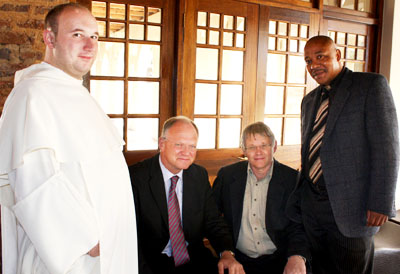 |
|
Present at the Calvin Research Conference were, from the left: Dr Frank Ewerszumrode (OP), Faculty of Catholic Theology at the University of Mainz in Mainz, Germany; Prof. Dr Herman Selderhuis, President of the International Congress on Calvin Research; Prof. Dolf Britz, Director of the Jonathan Edwards Centre Africa at the UFS; and Ntabanyane Tseuoa, Masters student in the Jonathan Edwards Centre at the UFS.
Photo: Leonie Bolleurs
|
The first International Congress on Calvin Research in Africa was this week presented on the Main Campus of the University of the Free State (UFS) in Bloemfontein. This was the tenth Calvin Research Conference presented. The conference is presented every four years.
The theme of the congress was: Reconciliation in the Theology of Calvin. Presentations were made about, amongst others, Calvin’s viewpoint regarding slavery and social justice. There was also a discussion about the extraordinary interest to record the original Calvin texts in databases and to make it available to researchers worldwide.
According to Prof. Dolf Britz, Director of the Jonathan Edwards Centre at the UFS, the objective of the congress was to study original Calvin sources critically. “An important part of the congress’ work is to publish an important part of Calvin’s work in a comprehensive text critical edition. This process is already well advanced and includes a number of unknown texts,” said Prof. Britz.
With its research on Calvin, the UFS emphasises the study of original theological sources. “This approach makes the Faculty of Theology part of the UFS’s strategy towards internationalisation. This is also one of the reasons why the UFS was selected by Yale University in America as partner in the recent establishment of the Jonathan Edwards Centre Africa,” said Prof. Britz, whose brainchild it was to also include young upcoming researchers with the study of original sources and classical languages such as Latin.
The congress was attended by researchers and academics from across the world. Twenty young, emerging researchers formed part of this group that was invited by the UFS. According to Prof. Britz, these young researchers are the top achievers at their respective universities, such as the North-West University, Stellenbosch University, Mukanyo Theological College in the Pretoria area and the UFS.
At this event, attended by more than 70 world-renowned Calvin scholars from countries like, amongst others, Taiwan, Japan, South Korea, Finland, Switzerland, France, The Netherlands, America, Germany and Hungary; UFS academics like Prof. Eric de Boer, Extraordinary Professor in Classical and Reformed Theology and students like Rev. Ntabanyane Tseuoa from Lesotho, read and presented papers as well.
According to Prof. Britz this congress was a very good opportunity to introduce the UFS to the rest of the world.
Media Release
Issued by: Mangaliso Radebe
Assistant Director: Media Liaison
Tel: 051 401 2828
Cell: 078 460 3320
E-mail: radebemt@ufs.ac.za
31 August 2010